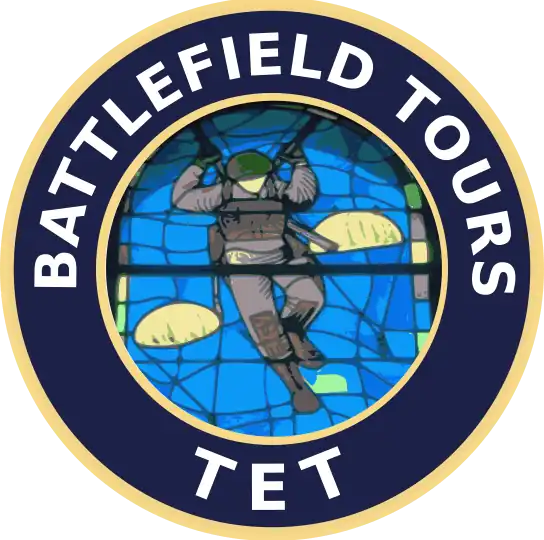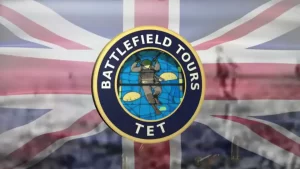Allied Airborne D-day Missions
British 9th Parachute Battalion
Between 5th and 7th June 1944, as part of Operation Overlord (the code name for the D-Day landings and Battle of Normandy in WWII), The British 6th Airborne Division undertook Operation Tonga as their D-day mission. Commanded by Major General Richard Nelson Gale, paratroopers and gilder-borne airborne troops of the 6th Airborne Division landed on the eastern flank of the invasion area, near to the city of Caen, tasked with a capturing two strategically important bridges which Allied ground forces needed to use to advance once the seaborne landings had taken place. They were also tasked to destroy several other bridges to deny their use to the Germans and secure several important villages and to destroy the Merville Gun Battery which Allied intelligence believed housed a number of heavy artillery pieces, which were capable of bombarding the nearest invasion beach (code-named Sword) and possibly inflict heavy casualties on the Allied troops landing on it. Having achieved these objectives, the division was then to create and secure a bridgehead focused around the captured bridges until they linked up with advancing Allied ground forces.
1st Canadian Parachute Battalion
On the evening on 5 June 1944 the 1st Canadian parachute battalion was transported to France in fifty aircraft. The battalion landed one hour in advance of the rest of the brigade in order to secure the Drop Zone (DZ). Thereafter they were ordered to destroy road bridges over the river Dives and its tributaries at Varaville, then neutralize strong points at the crossroads. In addition, the Canadians were to protect the left (southern) flank of the 9th Battalion, Parachute Regiment during that unit’s attack on the Merville Battery, afterwards seizing a position at the Le Mesnil crossroads, a vital position at the centre of the ridge.
A Company (Major D. Wilkins) would protect the left flank of 9th Btn during their attack on the Merville Battery and then cover 9th Battalion’s advance to the Le Plein feature. They would seize and hold the Le Mesnil cross roads.
B Company (Major C. Fuller) was to destroy the bridge over the river Dives within two hours of landing and deny the area to the enemy until ordered to withdraw to Le Mesnil cross roads.
C Company (Major H.M. MacLeod) was to secure the DZ, destroy the enemy headquarters (HQ), secure the SE corner of the DZ, destroy the radio station at Varaville, and blow the bridge over the Divette stream in Varaville. C Coy would then join the battalion at Le Mesnil cross roads.
The Battalion landed between 0100 and 0130 hours on June 6, becoming the first Canadian unit on the ground in France. For different reasons, including adverse weather conditions and poor visibility, the soldiers were scattered, at times quite far from the planned drop zone. By mid-day, and in spite of German resistance, the men of the battalion had achieved all their objectives. In the following days ahead, the Canadians were involved in ground operations to strengthen the bridgehead and support the advance of Allied troop.
Sword Beachhead
The Anglo-Canadian assault landings on D-Day were to be carried out by the British Second Army, under Lieutenant General Miles Dempsey. The Second Army’s I Corps, commanded by Lieutenant General John Crocker, was assigned to take Sword. Major General Tom Rennie’s 3rd Infantry Division had the task of assaulting the beaches and seizing the main British objective on D-Day, the historic Norman city of Caen. Attached to the 3rd Infantry Division for the assault were the 27th independent Armoured Brigade, the 1st Special Service Brigade, No. 41 Royal Marine Commando of 4th Special Service Bridgade, Royal Marine armoured support, additional artillery and engineers, and some of the 79th Armoured Division. 6th Beach Group was deployed to assist the troops and landing craft landing on Sword and to develop the beach maintenance area.
Juno Beachhead
Juno beach spanned from Courseulles, a village east of the British beach Gold, to Saint-Aubin-sur-Mer, west of the British beach Sword. Taking Juno was the responsibility of the Canadian Army. The landings initially encountered heavy resistance from the German 716th Division; the preliminary bombardment proved less effective than hoped and rough weather forced the first wave to be delayed until 07:35. Several assault companies, notably the Royal Winnipeg Rifles and the Queens Own rifles of Canada, took heavy casualties in the opening minutes of the first wave. Strength of numbers, coordinated fire support from artillery and armoured squadrons, cleared most of the coastal defenses within two hours of landing. The reserves of the 7th and 8th brigades began deploying at 08:30 along with the Royal Marines, while the 9th Brigade began its deployment at 11:40.
Gold Beachhead
The objectives at Gold were to secure a beachhead, move westward to capture Arromanches and establish contact with the American forces at Omaha. Bayeux and the small port of Port-en-Bessin was also to be captured to link up with the Canadian forces to the east at Juno. The British Commandos of No.47 Royal Marine Commando advanced on Port-en-Bessin and captured it on 7 June in the Battle-en-Bessin. The 1st Battalion, Hampshire Regiment captured Arromanches, and 69th Infantry Brigade on the eastern flank made contact with the Canadian forces at Juno Company Sergeant major Stanley Hollis received the only Victoria Cross awarded on D-Day for his actions while attacking two pillboxes at the Mont Fleury battery.




